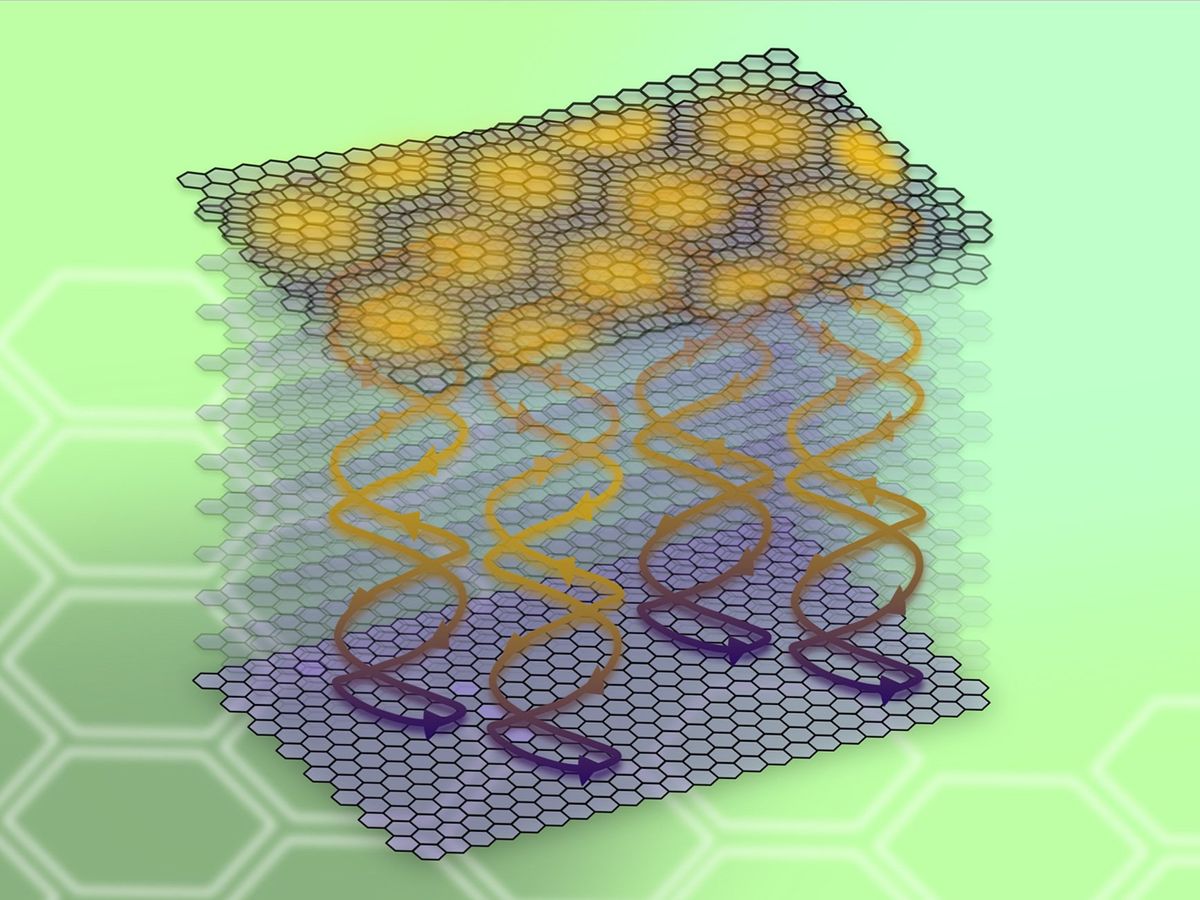Stacking two slightly askew sheets of graphene on top of one another has in recent years led to phenomenal physics—including tunable superconductivity, quantum memory, and strange new states of matter involving “puddled” clumps of electrons. The curious behavior of these systems emerge with a “twist” angle between the hexagonal pattern in the two sheets as small as 1.1 degrees. And with so much new physics cropping up, technological applications of so-called twisted bilayer graphene have only begun to be imagined, with mysterious thermal, optical, electronic, material and other properties just waiting to be developed.
Now, scientists in the United States and United Kingdom have begun exploring the outer limits of these stacked 2D systems: What if only one of those bilayers’ two layers was one-atom thick? How many layers can be added to the bulk until the bilayer magic is gone? To these researchers’ surprise, some of the bilayer properties persisted even inside thick, three-dimensional graphite stacks.
The strange behaviors now seen in graphite-plus-graphene is making researchers revisit odd properties of plain-old graphite, as observed since the 1970s.
“The common wisdom for some time was...if it’s a metal with many layers in it, it behaves like it’s three-dimensional,” says Vladimir Falko, professor of theoretical physics at the University of Manchester, in England. “It was quite unusual to see that in such a thick film of graphite, it was possible to see the two-dimensional behavior.”
In their pursuit of understanding the limits of thin-layer quantum behaviors, research teams from the University of Washington and the University of Manchester each created two slightly different setups. The University of Washington group topped a thick graphite stack with a single graphene layer, twisted at a slight angle. The University of Manchester team used a similar graphite stack, but instead topped it with a single layer of the two-dimensional sheet state of boron nitride.
Both approaches create the same structure between the top two layers of their stack—what’s called a moiré superlattice. It’s called a superlattice because the mismatched angle between the two layers adds new kinds of moiré-like patterns to the system. With a top layer of twisted graphene, the mismatch comes from the twist angle between each sheet’s hexagonal cells, whereas with a top layer of boron nitride, the mismatch comes from the slightly different lattice spacings of the boron nitride and the graphite underneath.
When subjected to strong magnetic fields, moiré superlattices undergo remarkable transformations due to the vastly increased lattice spacing. In this scenario, a significantly larger magnetic flux can now pierce a single lattice plaquette, transforming the material’s already strange properties yet further. As the field is tuned up, the conductivity of the sheet oscillates periodically, a phenomenon known as Brown-Zak oscillations.
The researchers did not expect their thick graphene stacks with a single moiré superlattice layer at the top to exhibit any such effects. Phenomena as described above, after all, had only been observed with a pair (or small array) of 2D sheets atop each other. A 3D chunk of graphite was new terrain entirely. And the teams had every reason to suspect the strange quantum behaviors would simply not be seen in the system. Nevertheless, as they tuned up their magnetic fields, the researchers observed oscillations in the conductivity of the entire stack—characteristic Brown-Zak oscillations of two-dimensional moiré materials.
“If you have 18 layers of graphite, and you twist just one of these layers by 1 degree, you’re not really making a very big structural change to the material,” says Matthew Yankowitz, who led the University of Washington effort. “But the entire graphite stack basically behaves like a moiré material, even though it’s a three-dimensional material. So that’s, I think, a funky new insight.”
While the superconducting properties and strong electron correlations observed in two-dimensional moiré superlattices do not persist in the three-dimensional bulk material, the teams’ observed Brown-Zak oscillations suggest that the bizarre characteristics of the 2D systems can be adopted even within thick graphite stacks. There may be a path toward reintroducing these more fascinating properties into bulk materials, Yankowitz says.
Moreover, the persistence of certain 2D behaviors in such thicker structures may explain some odd behaviors of graphite that have been observed as far back as the 1970s. “The behavior of graphite in a very strong magnetic field has been a bit of a mystery for a long time,” says Allan MacDonald, a physicist at the University of Texas at Austin, who did not participate in the work. “And these new papers may give a new handle on trying to understand what’s going on.”
This, Yankowitz says, opens up a new avenue of research in studying hybrid-dimensional materials. “Where this will lead right now is unclear, but it’s the foundation of understanding these new types of hybrid 2D-3D systems,” he says.
The two teams of researchers published their results of graphene-on-graphite and boron nitride-on-graphite in two papers in the journal Nature in July.
- Graphene Jolts Sodium-Ion Battery Capacity - IEEE Spectrum ›
- Breakthrough in Creating a Band Gap for Graphene Promises Huge ... ›
- Graphene Enables Invisibility Cloak - IEEE Spectrum ›
- In "Strange Metals," the Flow of Electricity Is Equally Strange - IEEE Spectrum ›
Dina Genkina is an associate editor at IEEE Spectrum focused on computing and hardware. She holds a PhD in atomic physics and lives in Brooklyn.



